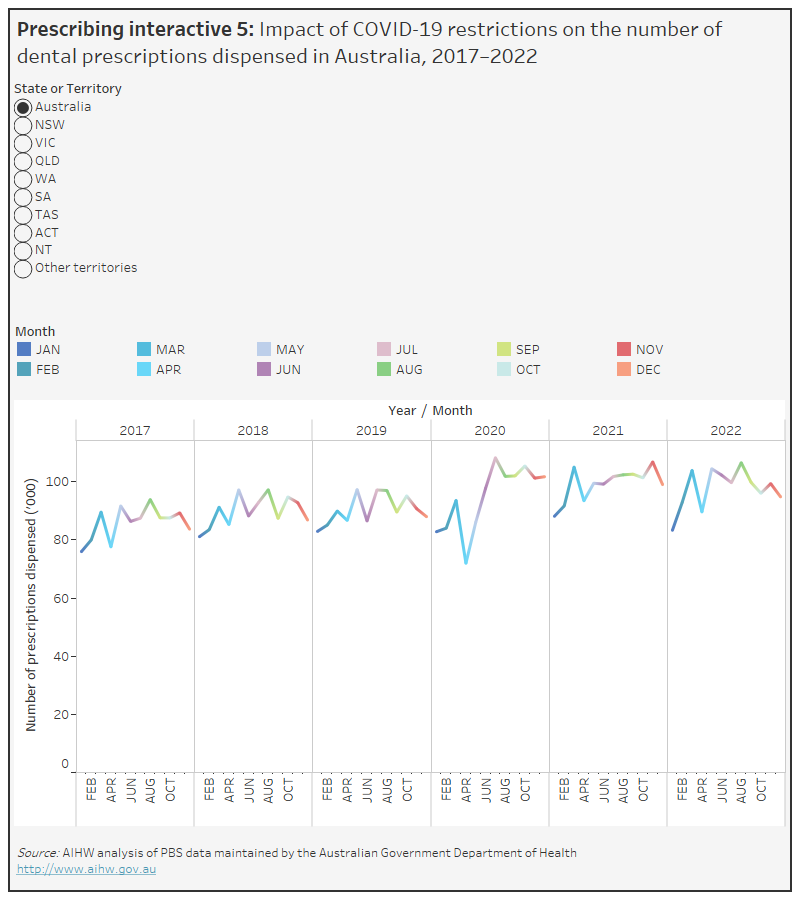Prescribing
The Commonwealth government subsidises the cost of prescription medicines through two separate schemes, the Pharmaceutical Benefits Scheme (PBS) and the Repatriation Pharmaceutical Benefits Scheme (RPBS) for eligible war veterans and their dependants. Medicines available under the PBS/RPBS and conditions of prescribing are listed in the Schedule of Pharmaceutical Benefits.
Most of the listed medicines are prescribed by doctors, but other health professionals such as dentists are also eligible to prescribe. Dentists are not able to prescribe general PBS items but have a separate Dental Schedule from which they can prescribe dental care medicines for their patients (Department of Health 2022a).
The following PBS/RPBS data relate to dental prescriptions, categorised by the Anatomical Therapeutic Chemical (ATC) Classification System as listed in the PBS Schedule.
It is important to highlight that some medications (such as codeine with paracetamol and ibuprofen) were also available over the counter before 2017. Therefore data for these medicines will be incomplete as over the counter sales are not captured in the PBS/RPBS data. Also, people may be prescribed medications for dental conditions by other health professionals (e.g. GPs) that are not captured under the Dental Schedule.
Key terms
- Pharmaceutical Benefits Scheme (PBS): A national, government-funded scheme that subsidises the cost of a wide range of pharmaceutical drugs for all Australians to help them afford standard medications. The Schedule of Pharmaceutical Benefits lists all the medicinal products available under the PBS and explains the uses for which they can be subsidised.
- Repatriation Pharmaceutical Benefits Scheme (RPBS): An Australian government scheme, subsidised by the Department of Veterans’ Affairs (DVA), that provides a range of pharmaceuticals and wound dressings at a concessional rate for the treatment of eligible veterans, war widows and widowers and their dependants.
Dental prescriptions: Dental care medicines listed on the Dental Schedule of Pharmaceutical Benefits that have been prescribed by dentists for their patients and supplied by pharmacies.
ATC: The Anatomical Therapeutic Chemical (ATC) Classification System is used for the classification of active ingredients of drugs according to the organ or system on which they act and their therapeutic, pharmacological and chemical properties.
The 15 most dispensed dental prescriptions are categorised by ATC as follows:
- J01: Antibacterials for systemic use: amoxicillin, amoxicillin with clavulanic acid, cephalexin, clindamycin, erythromycin, metronidazole and phenoxymethylpenicillin.
- M01: Antiinflammatory and antirheumatic products: diclofenac, ibuprofen, naproxen.
A01: Stomatological Preparations: amphotericin B.
- N02: Analgesics: codeine with paracetamol, oxycodone, tramadol.
- N05: Psycholeptics: diazepam.
Number of dental prescriptions dispensed
Over 1 million dental prescriptions were dispensed in Australia each year (2013–2022)
- Around 1.2 million dental prescriptions were dispensed in 2022.
- The number of dental prescriptions dispensed in Australia each year remains relatively stable, ranging from a low of about 1.0 million in 2017, to a high of about 1.2 million in 2021.
Explore the data using the Prescribing interactive 1 below.
Prescribing – Interactive 1
This figure shows the number of dental prescriptions dispensed in Australia. National, state and territory data is presented for 2013 to 2021. In Australia, there were 1,191,071 dental prescriptions dispensed in 2021.
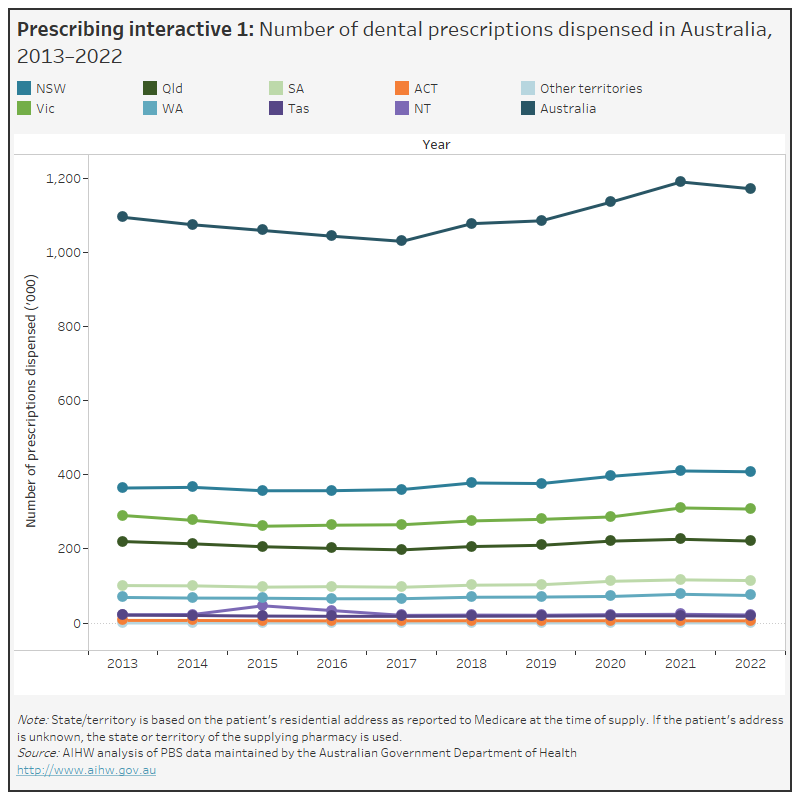
See Data tables: Prescribing for data tables.
Most commonly dispensed dental prescriptions
The 15 most commonly dispensed medicines accounted for 99% of all dental prescriptions dispensed in 2022
- Amoxycillin was the most commonly dispensed medicine during the period 2013–2022, accounting for around half of all dental items dispensed each year.
- Amoxycillin was dispensed just under 572,000 times in Australia in 2022.
- The second most commonly dispensed medicine during the period 2013–2022 was codeine with paracetamol, accounting for around one-fifth of dental items dispensed in 2021.
- Codeine with paracetamol was dispensed around 230,000 times in Australia in 2022.
Explore the data using the Prescribing interactive 2 below.
Prescribing – Interactive 2
This figure shows the fifteen most commonly dispensed dental prescriptions. National data is presented for 2013 to 2021. In Australia, the most commonly dispensed dental prescription was Amoxycillin, accounting for 48% of all dental items dispensed in 2021.
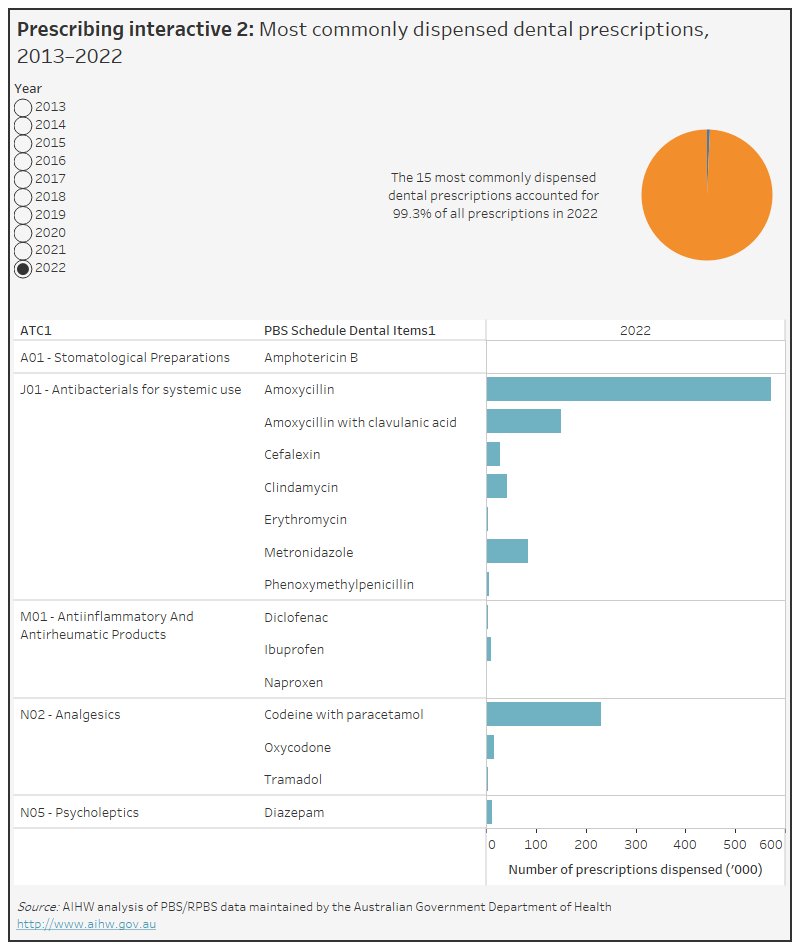
See Data tables: Prescribing for data tables.
The number of dental prescriptions dispensed for oxycodone has increased approximately five-fold over the last 10 years, from around 3,200 in 2013 to 15,900 in 2022
Between 2013 and 2022, the number of dental prescriptions dispensed has:
- doubled for amoxycillin with clavulanic acid, from around 74,500 in 2013 to around 150,000 in 2022
- steadily decreased for erythromycin, from around 15,600 in 2013 to around 4,200 in 2022
- steadily increased for diazepam from around 7,100 in 2013 to 12,600 in 2022.
Explore the data using the Prescribing interactive 3 below.
Prescribing – Interactive 3
This figure shows the characteristics of patients dispensed dental prescriptions, by sex, age and patient category. National data is presented for 2013 to 2022. In 2022, 50% of patients dispensed dental prescriptions were female.
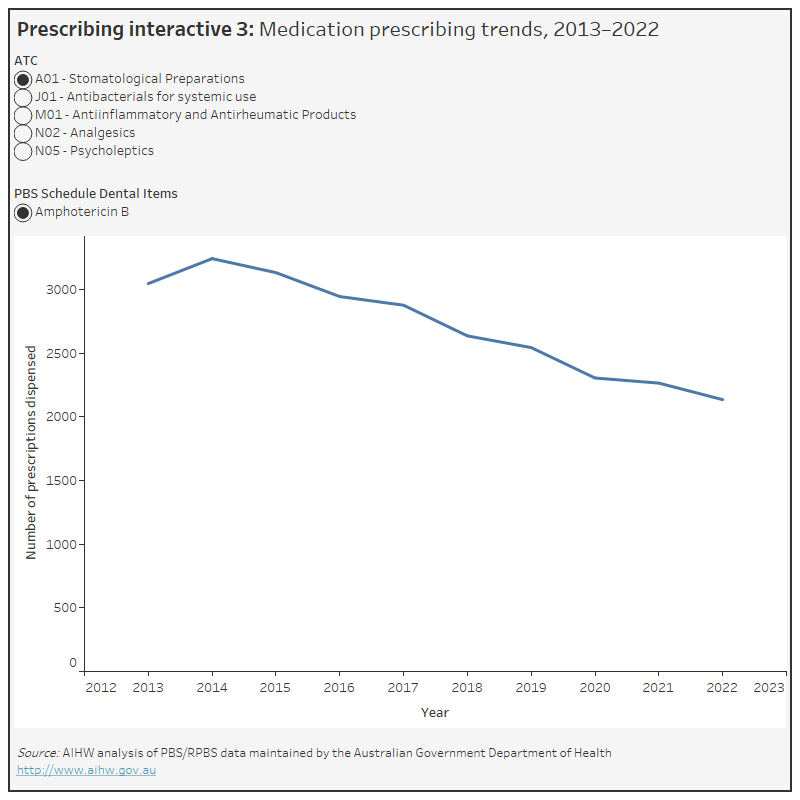
See Data tables: Prescribing for data tables.
This figure shows the number and rate of hospital separations requiring general anaesthesia for procedures related to dental conditions, by sex, remoteness and indigenous status. National data is presented for each year, for 2016–17 through to 2021–22. The rate of hospital separations requiring general anaesthesia fluctuated over the period from 2016-17 to 2021-22, from a low of 4.9 per 1,000 population in 2019–20 to a high of 6.1 per 1,000 population in 2020-21.
Characteristics of patients dispensed dental prescriptions
Most dental prescriptions were dispensed to females (2013–2022)
- In 2022, more dental prescriptions were dispensed to females (around 590,000 or 50%) than males (around 532,000 or 45%). The sex was missing for around 50,700 or 4.3% of dental prescriptions dispensed.
Around one-third of all dental prescriptions were dispensed to patients aged 45–64 years (2013–2022)
In 2022, the number of dental prescriptions dispensed to patients was:
- highest for those aged 45–64 years (around 393,000 or 34%)
- lowest for those aged 0–4 years (around 3,000 or 0.3%).
PBS patients fall into two broad categories: general and concessional. Concessional patients include Pensioner Concession Card holders, Commonwealth Seniors Health Card holders, Health Care Cared holders and DVA Pension Card holders. General patients do not hold any of the aforementioned cards. RPBS (or repatriation) patients hold DVA White, Gold or Orange Cards (Department of Health 2022b).
The majority of dental prescriptions were dispensed to general patients (2013–2022) rather than concessional or repatriation patients
- In 2022, around 410,000 (35%) dental prescriptions were dispensed to concessional patients and around 754,000 (64%) dental prescriptions were dispensed to general patients.
Explore the data using the Prescribing interactive 4 below.
Prescribing – Interactive 4
This figure shows the impact of COVID-19 restrictions on the number of dental prescriptions dispensed in Australia. Data is presented for 2017 through to 2022.
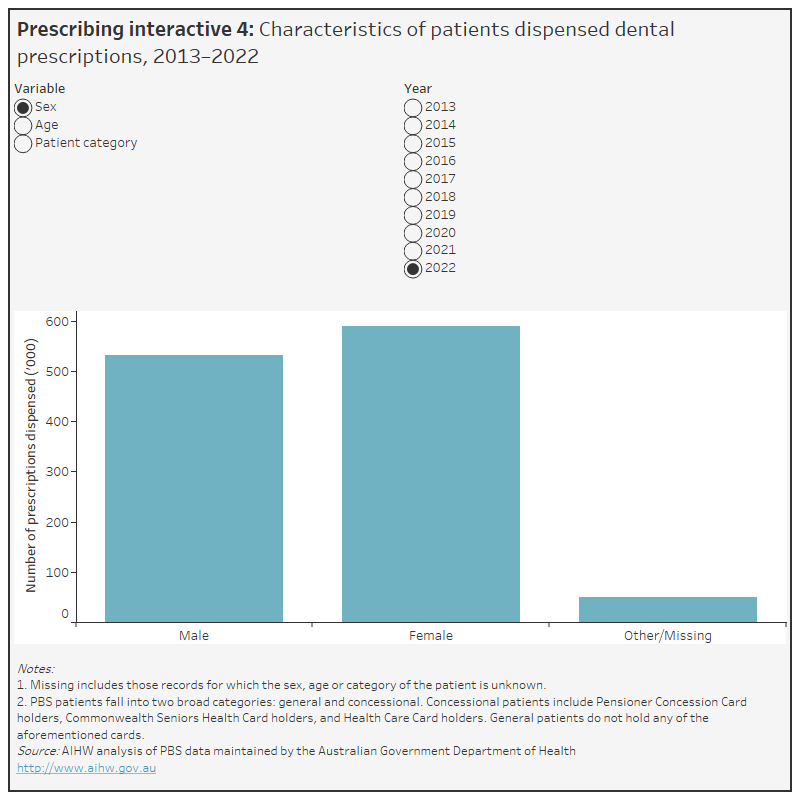
See Data tables: Prescribing for data tables.
Impact of COVID-19 restrictions on dental prescribing
The COVID-19 pandemic has impacted every aspect of the Australian health system, including the provision of dental care services (refer to Impact of COVID-19 on dental services for more detail).
COVID-19 pandemic restrictions had an impact on the number of dental prescriptions dispensed
- Around 72,000 dental prescriptions were dispensed in April 2020, as compared to the April average of around 83,000 between 2013-2019.
- In July 2020, once COVID-19 restrictions eased, the number of dental prescriptions dispensed increased to just over 108,000, the highest in any month since 2017 and in 2021 and 2022.
- In 2022, the number of dental prescriptions dispensed returned to levels slightly above that before the COVID-19 pandemic.
Explore the data using the Prescribing interactive 5 below.
References
Department of Health 2022a. The Pharmaceutical Benefits Scheme: Dental Items. Canberra: Department of Health. Viewed 22 February 2022.
Department of Health 2022b. The Pharmaceutical Benefits Scheme. Canberra: Department of Health. Viewed 27 February 2022.



